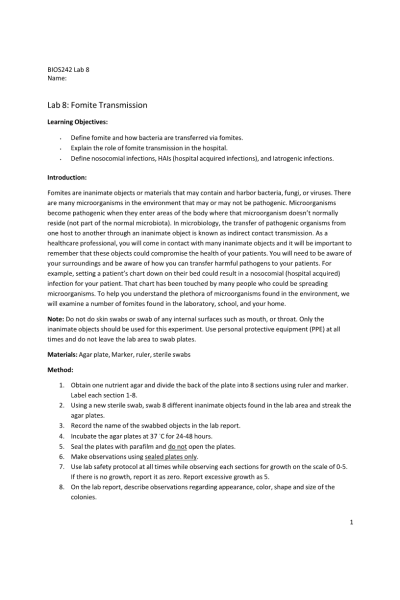BIOS 242 Week 4 Lab 2; Fomite Transmission
-
$20.00
| Institution | BIOS 242 Fundamentals of Microbiology with Lab - Chamberlain |
| Contributor | Anika Fultz |
Lab 8: Fomite Transmission
Learning Objectives:
- Define fomite and how bacteria are transferred via fomites.
- Explain the role of fomite transmission in the hospital.
- Define nosocomial infections, HAIs (hospital acquired infections), and Iatrogenic infections.
Introduction:
Materials: Agar plate, Marker, ruler, sterile swabs
Method:
- Obtain one nutrient agar and divide the back of the plate into 8 sections using ruler and marker. Label each section 1-8.
- Using a new sterile swab, swab 8 different inanimate objects found in the lab area and streak the agar plates.
- Record the name of the swabbed objects in the lab report.
- Incubate the agar plates at 37 ◦C for 24-48 hours.
- Seal the plates with parafilm and do not open the plates.
- Make observations using sealed plates only.
- Use lab safety protocol at all times while observing each sections for growth on the scale of 0-5. If there is no growth, report it as zero. Report excessive growth as 5.
- On the lab report, describe observations regarding appearance, color, shape and size of the colonies.
- Once observation is completed, immediately put the plates in appropriate waste container (biohazard bag) for autoclaving.
Lab Report:
Purpose: To see the bacteria, viruses, or fungi growth on inanimate objects which would refer to as fomite.
Results:
Growth Scale: 0= No Growth; 5= Maximum Growth
Questions:
- Differentiate between nosocomial, HAI, and iatrogenic infections.
- Describe three ways a nurse could transfer microorganisms to their patients.
- Differentiate between contact, vehicle, and vector transmission.
- Was there equal amount of growth on all sections? Would all microorganisms on a fomite be able to grow on nutrient agar? Why or why not?
| Instituition / Term | |
| Term | Uploaded 2023 |
| Institution | BIOS 242 Fundamentals of Microbiology with Lab - Chamberlain |
| Contributor | Anika Fultz |















































